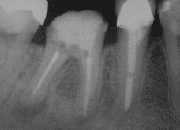
Photo from wikipedia
Abstract Background A comprehensive effort to evaluate outcomes of primary root canal therapy (RCT) between 1966 and 2002 was published by Ng et al. (2007, International Endodontic Journal, 40, 921;… Click to show full abstract
Abstract Background A comprehensive effort to evaluate outcomes of primary root canal therapy (RCT) between 1966 and 2002 was published by Ng et al. (2007, International Endodontic Journal, 40, 921; 2008, International Endodontic Journal, 41, 6). Changes in endodontic materials and treatment methods warrant an updated analysis of outcomes. Objectives This study aimed to (1) quantify the success rates of primary RCT published between 2003 and 2020; and (2) investigate the influence of some characteristics known/suspected to be associated with treatment outcomes. Methods An electronic search was performed in the following databases (01‐01‐2003 to 12‐31‐2020): Pubmed, Embase, CINHAL, Cochrane and Web of Science. Included study designs were longitudinal clinical studies (randomized control trials, cohort studies, retrospective observational studies). Studies with at least twelve‐months of post‐operative review and success rates based on clinical and radiographic criteria were analysed. The terms ‘strict’ (complete resolution of periapical lesion) or ‘loose’ (reduction in size of existing periapical lesion) were used to describe the outcome criteria. Weighted, pooled success rates were calculated. Random effects meta‐regression models were used to investigate potential sources of statistical heterogeneity. The Grading of Recommendations, Assessment, Development and Evaluation (GRADE) approach was used to evaluate for quality assessment of the included studies. Results Forty‐two studies were included in the review. Meta‐analyses showed that the weighted pooled success rates were estimated to be 92.6% (95% CI: 90.5%–94.8%) under ‘loose criteria’ and 82.0% (95% CI: 79.3%–84.8%) under ‘strict’ criteria. The most significant areas of study heterogeneity were year of publication and qualification of operator. The majority (64.29%) of studies were considered to be of low quality of evidence. Discussion Biological factors continue to have the most significant impact on RCT outcomes. The technological method of instrumentation had no significant effect. The quality of evidence was based primarily on study design and only randomized control trials were considered to be ‘high’ quality of evidence. Conclusions The reported success rates show improvement over time. Weighted success rates for studies with a minimum of four‐years follow‐up had better outcomes, compared to those with less than four years, when ‘strict criteria’ were used. Registration PROSPERO database (CRD42021226311).
Journal Title: International Endodontic Journal
Year Published: 2022
Link to full text (if available)
Share on Social Media: Sign Up to like & get
recommendations!